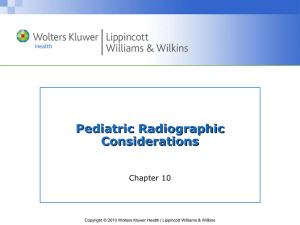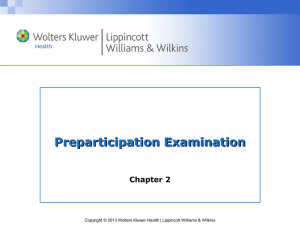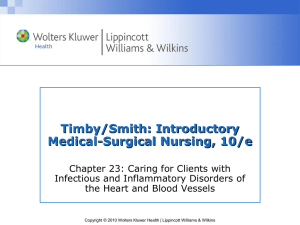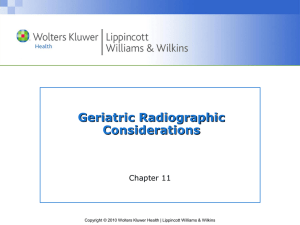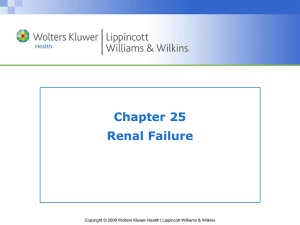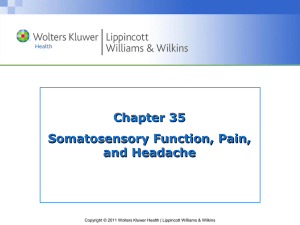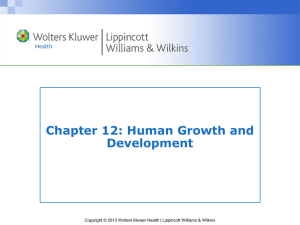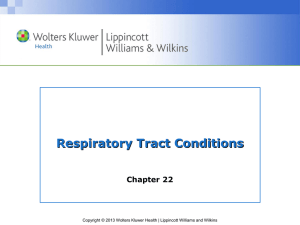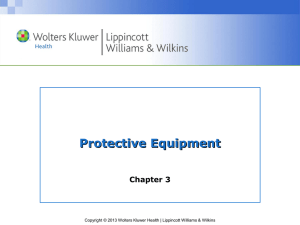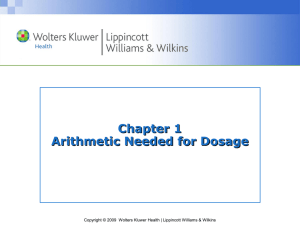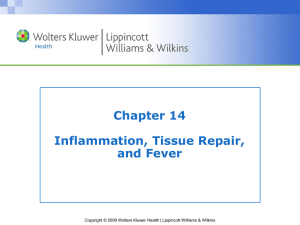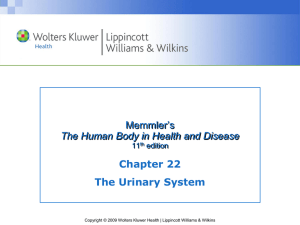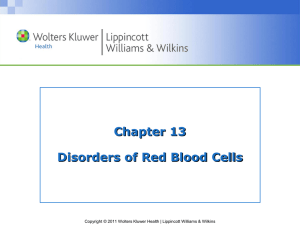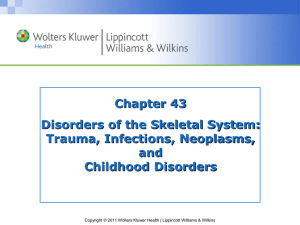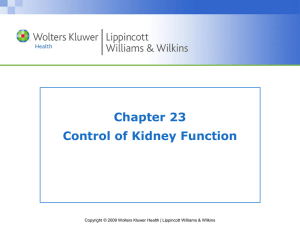Chapter 16 PPT
advertisement
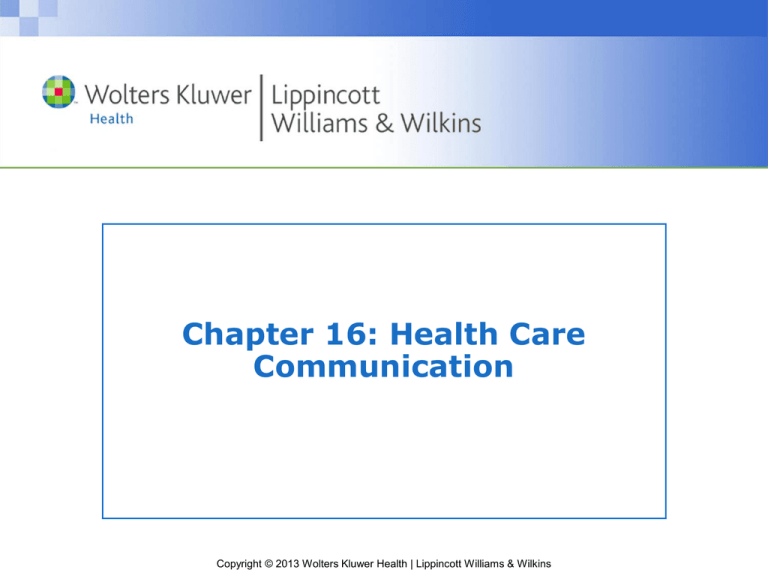
Chapter 16: Health Care Communication Copyright © 2013 Wolters Kluwer Health | Lippincott Williams & Wilkins Communication Process • Sender: person who transmits message • Message: information sender conveys • Receiver: person who gets message • Feedback: evaluation to ensure message was understood • Channel: medium by which message is sent Copyright © 2013 Wolters Kluwer Health | Lippincott Williams & Wilkins Communication Process (cont’d) • Flow of communication between a medical assistant and a patient Copyright © 2013 Wolters Kluwer Health | Lippincott Williams & Wilkins Communication Modes • Verbal Communication – General recommendations • Always use a polite tone • Always use proper English • Speak respectfully • Avoid using overly technical vocabulary Copyright © 2013 Wolters Kluwer Health | Lippincott Williams & Wilkins Communication Modes (cont’d) • Verbal Communication (cont’d) – Factors • Language • Manner & tone • Verbal encouragement • Humor Copyright © 2013 Wolters Kluwer Health | Lippincott Williams & Wilkins Communication Modes (cont’d) • Verbal Communication (cont’d) – Non-language sounds • Sighs • Sobs • Laughs • Grunts Copyright © 2013 Wolters Kluwer Health | Lippincott Williams & Wilkins Communication Modes (cont’d) • Verbal Communication (cont’d) – Assertive communication • Have empathy • Describe feelings or the situation • Clarify expectations • Anticipate consequences Copyright © 2013 Wolters Kluwer Health | Lippincott Williams & Wilkins Communication Modes (cont’d) • Verbal Communication (cont’d) – Active listening • Give your full attention to the person speaking • Don’t interrupt • Pay attention to the speaker’s body language & nonverbal cues Copyright © 2013 Wolters Kluwer Health | Lippincott Williams & Wilkins Communication Modes (cont’d) • Nonverbal Communication – Eye contact • Shows interest in other person • Lends sense of truthfulness to your message • In other cultures, may have negative connotation Copyright © 2013 Wolters Kluwer Health | Lippincott Williams & Wilkins Communication Modes (cont’d) • Nonverbal Communication (cont’d) – Kinesics or body movement • Facial expressions • Gestures • Eye movement Copyright © 2013 Wolters Kluwer Health | Lippincott Williams & Wilkins Communication Modes (cont’d) • Nonverbal Communication (cont’d) – Proxemics or personal space • Larger when talking to a stranger • Becomes smaller the better you know someone • Typically larger between two men than between two women • Differs from culture to culture Copyright © 2013 Wolters Kluwer Health | Lippincott Williams & Wilkins Communication Modes (cont’d) • Nonverbal Communication (cont’d) – Touch • Can create either positive or negative feelings • Watch for nonverbal cues that show how the patient feels about being touched • Maintain proper personal space, position, & posture • Observe patient’s facial expressions & posture Copyright © 2013 Wolters Kluwer Health | Lippincott Williams & Wilkins Communication Modes (cont’d) • Written Communication – Types • Agendas for meetings • Letters • Messages • Patient charts Copyright © 2013 Wolters Kluwer Health | Lippincott Williams & Wilkins Communication Modes (cont’d) • Written Communication (cont’d) – Guidelines for writing • Be concise • Use language all parties will understand • Use proper grammar • Check spelling Copyright © 2013 Wolters Kluwer Health | Lippincott Williams & Wilkins Communication Modes (cont’d) • Written Communication (cont’d) – Organizational strategies for writing • Chronological • Problem-oriented • Comparison Copyright © 2013 Wolters Kluwer Health | Lippincott Williams & Wilkins Communication Modes (cont’d) • Written Communication (cont’d) – Medical writing: things to pay attention to • Spelling • Capitalization • Abbreviations & symbols • Numbers Copyright © 2013 Wolters Kluwer Health | Lippincott Williams & Wilkins Communication With Patients • Patient Interviews – General guidelines • Listen actively • Ask appropriate questions • Record information accurately • Protect patient’s privacy • Be organized • Avoid attending to distractions • Let patient know who will see her next & when Copyright © 2013 Wolters Kluwer Health | Lippincott Williams & Wilkins Communication With Patients (cont’d) • Patient Interviews (cont’d) – Basic interview techniques • Reflecting • Paraphrasing • Clarification • Open-ended questioning • Summarizing • Silences Copyright © 2013 Wolters Kluwer Health | Lippincott Williams & Wilkins Communication With Patients (cont’d) • Patient Interviews (cont’d) – New patient interviews • Patient’s medical & family history • Brief review of body systems • Patient’s social history • Patient’s medications Copyright © 2013 Wolters Kluwer Health | Lippincott Williams & Wilkins Communication With Patients (cont’d) • Patient Interviews (cont’d) – Established patient interviews • Review patient’s chart for health problems • Ask questions about current medical problems & changes in health • Ask about known allergies • Record patient information Copyright © 2013 Wolters Kluwer Health | Lippincott Williams & Wilkins Communication With Patients (cont’d) • Patient Education – Assess – Plan – Implement – Evaluate – Document Copyright © 2013 Wolters Kluwer Health | Lippincott Williams & Wilkins Communication With Patients (cont’d) • Example of a pictogram that might be given to patients to help them understand medication administration Copyright © 2013 Wolters Kluwer Health | Lippincott Williams & Wilkins Recording and Reporting • Record patient information completely & precisely • Record information only in secure & appropriate locations • Record any action you take concerning a patient Copyright © 2013 Wolters Kluwer Health | Lippincott Williams & Wilkins Communication Challenges • Medical terminology unfamiliar to patient • Distractions: pain, hunger, noisy environment • Language barriers • Hearing impairment • Cognitive impairment • Anger or upset • Grief Copyright © 2013 Wolters Kluwer Health | Lippincott Williams & Wilkins Telephone Manners • Answer phone promptly—by second ring, if possible • Identify yourself & your office to caller • Speak politely • Never put a caller on hold immediately after answering Copyright © 2013 Wolters Kluwer Health | Lippincott Williams & Wilkins
